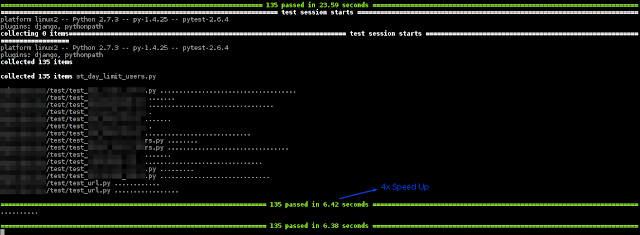Testing in software development is a tedious task, and some programmers skip it. But many start to do the right thing from the beginning, Test Driven Development (TDD) movement make software developer more aware on delivering properly tested battle proven software. I also using TDD with my Django development.
One of factor when your test getting more and more in quantity, the test running slow as the test increased as your software getting more complex. I notice that my test is 135 cases, and need to wait 25 seconds to finish all the test. The test way run using py.test and using Django test also. Of course the test using SQLite on memory database to speed up the test. Also Pytest give the test speed an increase.
Then i read on documentation that for testing, Django still using default setup on other thing in the framework which can be removed in testing environment, like no middleware, no add on or things that slowing down. 1 i try are change the password hashed in django. The password hasher used by Django authentication was PBKDF2 algorith with a SHA256 hash, a password strecthing mechanism recomended by NIST. This should be sufficient for most users. It's quite secure, requiring massive amounts of computing time to break. This was from Django documentation. Sure it is save, and sure need more time and processing power to encrypt it. So can we change it in testing environment, to a faster password hasher. Especially when in testing, we have a lot of login and logout session, and it will make the testing longer.
You see in the documentation also state that django have other hasher, one is md5 which is common used for hasing a file and fast enough. Try to use that in the test environment and change the password hasher settings and see the improvement gains. Of course you need to have a test.py settings file used for your testing environment database and other config. Add this entries for hashing using md5.
#Use faster password hasher for testing
PASSWORD_HASHERS = (
'django.contrib.auth.hashers.MD5PasswordHasher',
)
Then below the result when using md5 password hasher.
One of factor when your test getting more and more in quantity, the test running slow as the test increased as your software getting more complex. I notice that my test is 135 cases, and need to wait 25 seconds to finish all the test. The test way run using py.test and using Django test also. Of course the test using SQLite on memory database to speed up the test. Also Pytest give the test speed an increase.
Then i read on documentation that for testing, Django still using default setup on other thing in the framework which can be removed in testing environment, like no middleware, no add on or things that slowing down. 1 i try are change the password hashed in django. The password hasher used by Django authentication was PBKDF2 algorith with a SHA256 hash, a password strecthing mechanism recomended by NIST. This should be sufficient for most users. It's quite secure, requiring massive amounts of computing time to break. This was from Django documentation. Sure it is save, and sure need more time and processing power to encrypt it. So can we change it in testing environment, to a faster password hasher. Especially when in testing, we have a lot of login and logout session, and it will make the testing longer.
You see in the documentation also state that django have other hasher, one is md5 which is common used for hasing a file and fast enough. Try to use that in the test environment and change the password hasher settings and see the improvement gains. Of course you need to have a test.py settings file used for your testing environment database and other config. Add this entries for hashing using md5.
#Use faster password hasher for testing
PASSWORD_HASHERS = (
'django.contrib.auth.hashers.MD5PasswordHasher',
)
I try run my test, the improvement was really fast. Here are the screenshoot of my test without the md5 password hasher which using default hasher.
 |
| Raw Django Test |
 |
| Optimized Django Test |
So the improvement was 4 times the speed on testing. Total of 135 test case. I am happy to write my test again as much as possible to increase the quality of my code. Make testing a habit. No more worries when change something on the code will break other part of the code. Test suite will come to the rescue.
Happy Testing and Happy Coding. Testing and Coding should be fun with python.













